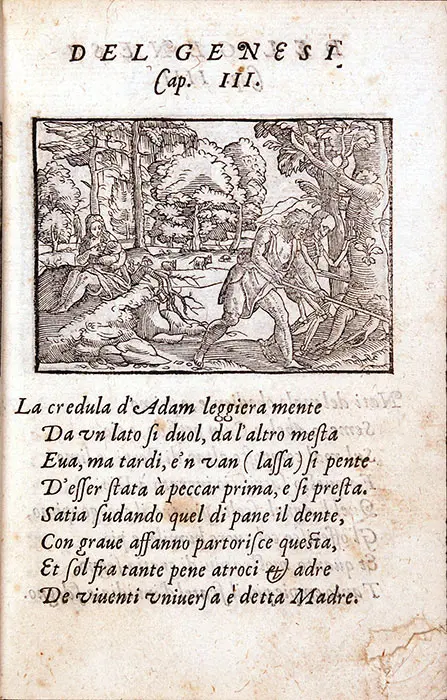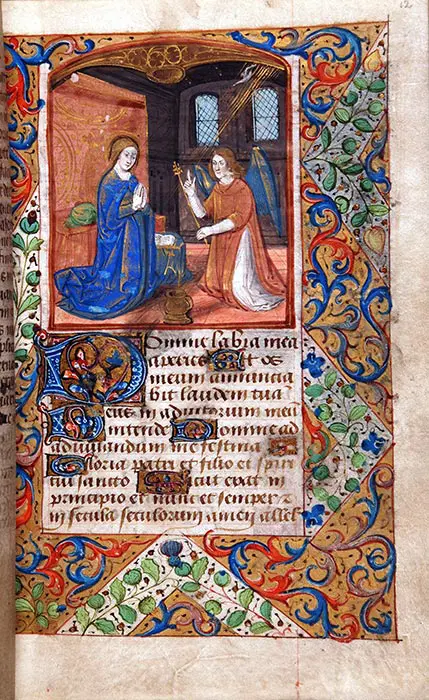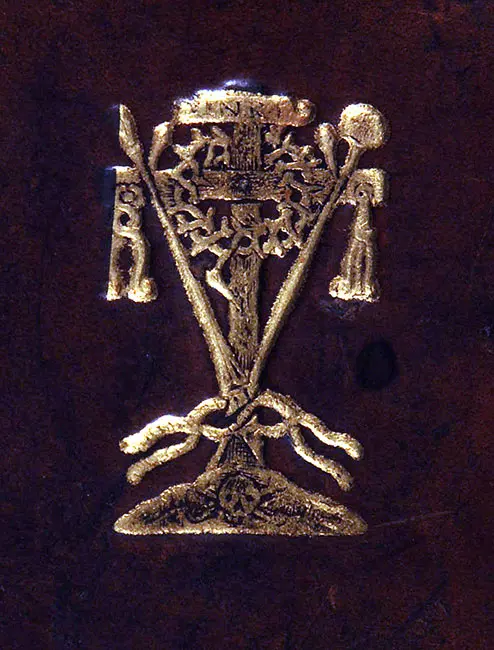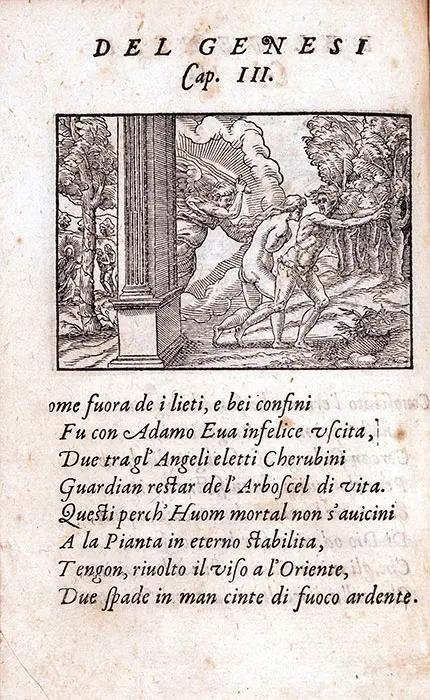Case 2
- The Fall of Man & Annunciation

Gabriele Simeoni. Figure del Vecchio Testamento: Illustrate di bellisime stanze volgari … RBP Italian Selections 1574
This image shows the expulsion of Adam and Eve from the Garden of Eden and is a symbolic depiction of humanity’s fall from grace.
The Tree of Knowledge from which Eve was tempted to take the fruit that caused their expulsion is visible at the left-hand side, while the shamed and naked couple is driven out into the wilderness by the Archangel Gabriel.

Gabriele Simeoni. Figure del Vecchio Testamento: Illustrate di bellisime stanze volgari … RBP Italian Selections 1574
Open image in new window

Book of Hours, in Latin and French. Northern France (perhaps Rouen), late-fifteenth or sixteenth century. Reed MS8
As punishment for their disobedience Adam and Eve (and all their descendants) were condemned to die. Men were destined to toil in hard labour and women to suffer in childbirth.
The image at right shows Adam at work and being shadowed by a skeleton – the symbol for death – holding an hourglass, which represents the passage and time and a reminder that humanity is mortal. In the background is Eve nursing the infant Cain.

Book of Hours, in Latin and French. Northern France (perhaps Rouen), late-fifteenth or sixteenth century. Reed MS8
Open image in new window

Book of Hours, in Latin and French. Northern France (perhaps Rouen), late-fifteenth or sixteenth century. Reed MS8
The figures in this image are the Virgin Mary and Archangel Gabriel. Mary, clad in her blue mantle, a symbol of heavenly love, is told by the Archangel that she is to bear the son of God. The fact that Gabriel is kneeling represents the deference paid to the mother of Christ. A dove, the sign of the Holy Spirit, is visible descending towards Mary from just above the windows.
The open book, shown lying on a prie-dieu, is an iconographic interpretation of Mary as Sophia (Wisdom). It expresses the economic position of women book owners, and also represents Mary’s foreknowledge that her child is born to die (Apostolos–Cappadona 30). Placed between the figures is a jar, a sign of cleanliness, holding a lily, which is symbolic of purity and a signifier of the Virgin Mary.
Diane Apostolos–Cappadona. Dictionary of Christian Art. New York: Continuum, 1994.

Book of Hours, in Latin and French. Northern France (perhaps Rouen), late-fifteenth or sixteenth century. Reed MS8
Open image in new window

Gabriele Simeoni. Figure del Vecchio Testamento: Illustrate di bellisime stanze volgari … Venice: Niccolò Bevilaqua, 1574
Iconography is not limited to grand works of art and illustrated texts. The 33mm-high stamp present on the sixteenth-century binding of this Book of Hours is made of objects from the Arma Christi, or instruments used in Jesus Christ’s Passion.
Represented along with the Cross upon which Jesus was crucified are: the Crown of Thorns, the Holy Lance used to inflict the final wound, the Holy Sponge affixed to a reed with which gall and vinegar were offered to Jesus, the Titulus Crucis attached to the cross and inscribed ‘INRI’ (Iesus Nazarenus Rex Iudaeorum, ‘Jesus of Nazareth, King of the Jews’), the Nails that inflicted the four wounds on his hands and feet, and the pincers used to remove them.
The skull and crossed bones at the foot of the Cross refer to the site where the Crucifixion took place, Golgotha, glossed as ‘place of the skull’ in Greek. According to Christian tradition this was also the location where the first man, Adam, was buried.

Gabriele Simeoni. Figure del Vecchio Testamento: Illustrate di bellisime stanze volgari … Venice: Niccolò Bevilaqua, 1574
Open image in new window



